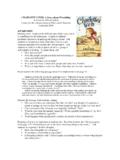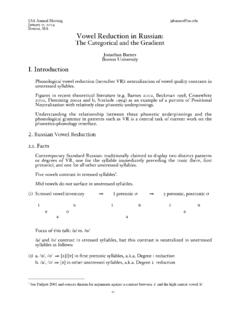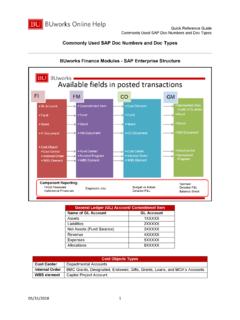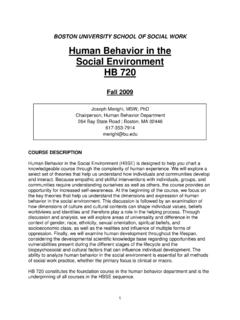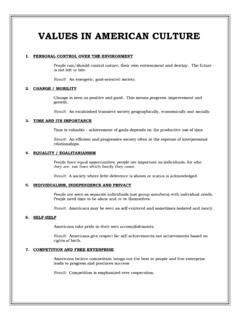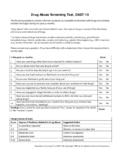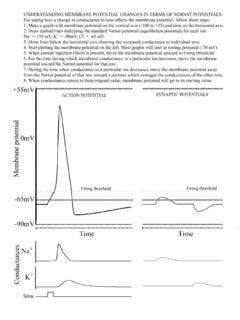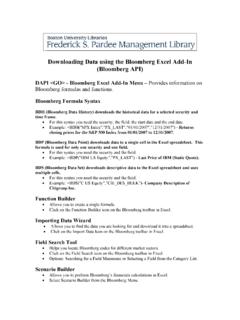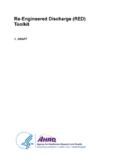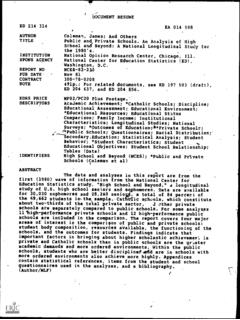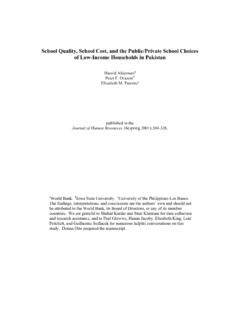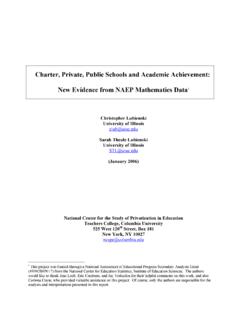Transcription of The quality of public education and private school ...
1 The quality of public education and private schoolenrollment: an assessment using brazilian data Fernanda Estevan AbstractIn this paper, we test the hypothesis that private school enrollment is the house-holds response to the low quality of public schools. In order to deal with thesimultaneity issue, we explore variations in public school funding caused by theFUNDEF reform that occurred in Brazil in 1998. using data from the BrazilianSchool Census, we show that a positive impact of the reform is associated with animmediate reduction in the share of private enrollment for the first grade of primaryschool at the municipality level. The same effect is not observed for the subsequentprimary school years. This confirms the intuition that the parents may be reluctantto switch schools after the beginning of their child s schooling track.
2 Our estimationresults are robust to variations in the school participation and changes in the incomedistribution. Thus, the improvement in the quality of public schools originated bythe FUNDEF reform has attracted households that would otherwise enroll in pri-vate institutions. The same mechanism seems to explain the increase in the netattendance rate during the same period. I thank Jean-Marie Baland, David de la Croix, Randall Ellis, Andr e C. Mart nez Fritscher,Thomas Gall, Jean Hindriks, Kevin Lang, Jean-Fran cois Maystadt, Walter Steingress, Eric Strobl,Alejandra Traferri, Miguel Urquiola, Vincent Vandenberghe, Eric Verhoogen, and Marian Vidal-Fern andez for very useful comments at different stages of this research.
3 This paper has beenpresented at the Doctoral Workshop at Universite catholique de Louvain, EUDN Doctoral Workshopat Oxford University and Microeconomics Dissertation Workshop at Boston University and hasgreatly benefited from their participants suggestions. I started this research while visiting CERGE-EI, Prague, under a Marie-Curie Host Fellowships for Early Stage Training (EST) in public Policy,Market Organization and Transition Economies. Financial support from this fellowship is fullyacknowledged. The final version of the paper was written while I was a visiting PhD researchscholar in the Institute for Economic Development at Boston University. All remaining errors aremine. PhD candidate, Department of Economics, CORE, Catholic University of Louvain - 34, Voiedu Roman Pays - 1348 - Louvain la Neuve, Belgium - Phone: +32 10 47 83 06 - Fax: +32 10 47 4301,e-mail IntroductionThe question of whether public expenditure in education crowds out private in-vestments is central for policy purposes.
4 The overall effect of a public policy oneducation cannot be correctly assessed without taking into account the changes inthe private investment made by the prominent way by which such crowding out may take place is on the option ofpublic versus private schooling. The household s choice of private education whenschools are publicly available is generally assumed to be quality -driven. However,the school s inputs are only one component of its perceived quality . The parentstake also into account the characteristics of the student body in opting for privateversus public schools (O Shaughnessy, 2007). Therefore, an increase in the publicschool resources would not necessarily lead them to modify their enrollment decision,unless it causes a sufficiently high number of private school pupils to switch to , a policy aimed at improving the quality of public schools may attract ornot pupils that would otherwise enroll at private schools.
5 The number of switchersmay be quite small or even absent whenever there is a large difference in school com-position between public and private schools or the parents attach a lot of importanceto the school s student attempts to analyze the impact of the quality of public schools on thedemand for private education pointed out the difficulties arising from the endogene-ity of public expenditures in education (Glick and Sahn, 2006). The main concern isrelated to the simultaneity of the enrollment and public expenditure decisions. In-deed, enrollment in private schools itself may cause a low level of public expenditurein education resulting in a poor quality of public schools. This is a consequence ofthe decrease in political support for public expenditures on education caused by ahigh proportion of households opting out of public this paper, we analyze how a variation in the quality of public schools affectsthe share of private school enrollment in a given municipality.
6 A negative impact ofan increase in public school quality on the share of private enrollment will be inter-preted as evidence of a crowding out effect. In order to cope with the simultaneityissue, this paper explores the effect of the FUNDEF2reform held in Brazil in literature investigating the political economy of public school expenditures when privateschools are available includes Stiglitz (1974), Epple and Romano (1996b), Glomm and Ravikumar(1998), Blomquist and Christiansen (1999), and, more recently, de la Croix and Doepke (2009).2 Fundo de Manuten c ao e Desenvolvimento do Ensino Fundamental e de Valoriza c ao do Mag-ist erio-Fund for the Maintenance and Development of the Fundamental education and Valuingof Teaching.
7 The fundamental education corresponds to the four years of primary school and thesubsequent four years of the so-called low argue that FUNDEF constitutes an interesting natural experiment for our pur-pose, since it renders public investment in education exogenous at the will focus on primary education (grades 1 to 4), corresponding to childrenaged 7 to 10. This has at least two advantages. The first is that we can be quiteconfident that public schools are available all over the country for these educationallevels and so that the absence of public schools will not be driving the demand forprivate second is that parents may be reluctant to switch schoolsafter the beginning of the child s schooling track. The focus on the first years shouldminimize this paper is organized as follows.
8 In Section 2 we discuss the related literatureand some empirical works that focus on the FUNDEF reform. In Section 3 we solvea simple model that helps us determine some of the effects we expect to find in thedata. In Section 4 we outline the brazilian educational system and the FUNDEF reform. In Section 5 we present some descriptive statistics and in Section 6 wedescribe our empirical strategy. We present the main estimation results in Section7, some robustness checks in Section 8, and our conclusions in Section 9. In AppendixA, we describe the Review of the literatureThe relation between the quality of public education and public / private school en-rollment has been investigated from several strand of the literature concentrates on the impact that the quality of educa-tion has on both public and private school enrollment .
9 using household surveys andcommunity data, Glick and Sahn (2006) have estimated demand functions for publicand private schools using data from rural distinguishing featureof Glick and Sahn (2006) with respect to previous studies is that they consider thatnot all individuals have the same number of schooling options from which to also explicitly control for endogeneity of school characteristics by includingthe average education of household heads, median village household expendituresper capita, and an indicator of urban location. They find that public school qualityindicators (such as distance to school , lack of teachers, multigrade classes, and fa-3In theory, the public schools in Brazil cannot refuse a student who has no other option in thesame municipality.)
10 For this reason, some public schools work with large groups or operate in severalperiods, reducing the number of hours of classes per estimation of the demand functions was not the ultimate objective of this study. Theirmain purpose was to simulate policy alternatives such as improvements in the quality of schoolsfinanced by tuition condition) have negative effects on public school enrollment . In the case ofprivate schools, none of the school characteristics have significant effects on et al. (2001) collected data on Pakistan s households and first explicitly consider the option of attending school and subsequently ana-lyze the choice between public and private schools. In their model, the decision toenroll or not relies on household characteristics such as income, sex, and parents education .
